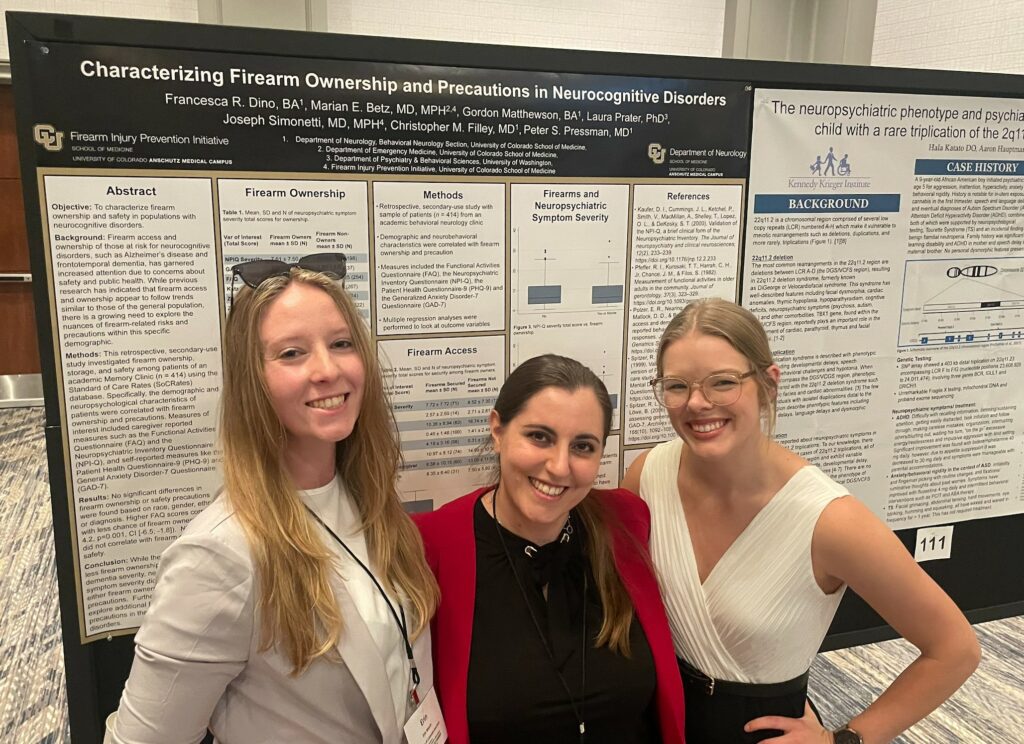Highlights from ANPA’s 34th Annual Meeting

The American Neuropsychiatric Association (ANPA) recently concluded its 34th Annual Meeting, an event that showcased cutting-edge research in a variety of fields including cognitive, emotional, and behavioral science. ANPA is a non-profit organization of professionals in behavioral neurology, neuropsychiatry, neuropsychology, and the clinical neurosciences with a mission to improve the lives of people with disorders at the intersection of psychiatry and neurology. ANPA has grown to over 500 members from around the world, including several CSAND Lab members!
Comprising internationally renowned clinician-scientists and clinician-educators, the ANPA Annual Meeting fosters collaboration and innovation in clinical care and research. The conference provides a platform for over 120 clinician-scientists to present a series of insightful presentations that shed light on the intersection of neuropsychiatric conditions and various societal concerns. Many insights came from the study and care of individuals across a spectrum of neurodevelopmental disorders, acquired neurological conditions, neurodegenerative disorders, and psychiatric disorders.
Representatives from the CSAND Lab presented three separate posters on elder abuse, hoarding behaviors, and firearm ownership within populations with neurocognitive disorders. A summary of these presentations are included below.
A Screening Tool for the Assessment of Hoarding: Preliminary Observations
Authors: Julia Schaffer1, Kelly Finch1, Christopher M. Filley1,2, Peter Pressman1
University of Colorado, Aurora, USA1
Marcus Institute for Brain Health, Aurora, Colorado2
This study focused on hoarding behavior, historically linked to psychological conditions, but now being more closely examined in the context of neurocognitive disorders. Researchers utilized a single-item screening tool to identify hoarding tendencies within an academic memory clinic population. Findings revealed that mild hoarding tendencies correlated with increased neuropsychiatric symptom severity and caregiver distress, underscoring the need for efficient screening tools to identify such behaviors that significantly impact patients and caregivers.
Characterizing patients with concerning Elder Abuse Suspicion Index (EASI) scores
Authors: Erin Marsh1,2, Elizabeth Bloemen1, Francesca Dino1, Gordon Matthewson1, Peter Pressman1
University of Colorado Anschutz Medical Campus, Aurora, USA1. University of Colorado Boulder, Boulder, USA2
This presentation highlighted the global issue of elder abuse, emphasizing the utility of the Elder Abuse Suspicion Index (EASI) for its detection. Our study presented compelling evidence that caregivers’ reports of neuropsychiatric symptoms were significantly higher in patients with concerning EASI scores. This relationship underscores the need for systematic tools like the EASI in clinical settings to better identify and address elder abuse, which often goes underreported.
Characterizing firearm ownership and precautions in neurocognitive disorders
Authors: Francesca Dino1, Emmy Betz1,3, Gordon Matthewson1, Laura Prater2, Joseph Simonetti3, Peter Pressman1
University of Colorado, Anschutz Medical Campus, Aurora, USA1
University of Washington, Seattle, USA2
Firearm Injury Prevention Initiative, University of Colorado, Anschutz Medical Campus, Aurora, USA3
Our last study discussed firearm ownership and safety precautions in individuals with neurocognitive disorders. It provided insights into the demographic and neuropsychological characteristics correlated with firearm ownership and safety measures. Notably, higher dementia severity correlated with a lesser likelihood of firearm ownership, yet neuropsychiatric symptom severity did not affect firearm ownership or safety precautions. This finding calls for further research, strategy development, and clinician and patient advocacy regarding firearm safety in this vulnerable population.
Not only did our lab complete three presentations, but we also wanted to briefly highlight two presentations from our esteemed colleagues at the CU Alzheimer’s and Cognition Center (CUACC):
A case of Alzheimer’s disease with contribution from frontal brain sagging syndrome with underlying Progranulin mutation – Hickam’s dictum partially explained by Occam’s razor
Tara Carlisle1, Samantha Petrucci1, Andrew Callen1, Brianne Bettcher1
University of Colorado Anschutz Medical Campus, Aurora, USA1
This case study delves into the intricate interactions of different brain disorders, shedding light on the difficulties in diagnosing conditions with overlapping symptoms. Initially, a 75-year-old woman showed subtle cognitive changes that resembled Alzheimer’s disease (AD), dementia with Lewy bodies (DLB), and frontal brain sagging syndrome (FBSS). However, further investigation revealed a genetic cause, a Progranulin mutation. This highlights the importance of considering genetic factors in diagnosing brain disorders, challenging the idea that complex symptoms always mean multiple problems. By favoring a single, genetic explanation (Occam’s razor), the diagnostic process becomes clearer.
Nature’s Finest Masterpiece: Recent Findings on Why White Matter Matters
Author: Christopher M. Filley1
University of Colorado, Anschutz Medical Campus, Aurora, USA1
Despite historically being overlooked, white matter is now understood as crucial for brain function. This study explores recent evidence showing how white matter is essential for higher-level thinking and emotions. Research suggests that white matter has grown significantly during evolution, especially in areas related to attention, memory, language, and social skills. Studies on children learning to read indicate that white matter helps shape brain development. Damage to white matter, as seen in strokes, often causes more severe cognitive problems than damage to gray matter. These findings highlight the importance of white matter in brain function, supporting the idea that it is nature’s masterpiece.
The CSAND Lab is excited to have continued our mission to expand our ability to diagnose and care for individuals with neurocognitive disorders throughout all communities and shed light on crucial aspects of neuropsychiatric conditions and their broader social implications. We hope to illustrate the importance of developing targeted strategies to address the complex needs of individuals with neurocognitive disorders and highlight the potential of screening tools in improving patient and caregiver outcomes.
Thank you to ANPA for this wonderful opportunity!
Written with assistance from ChatGPT-4.
